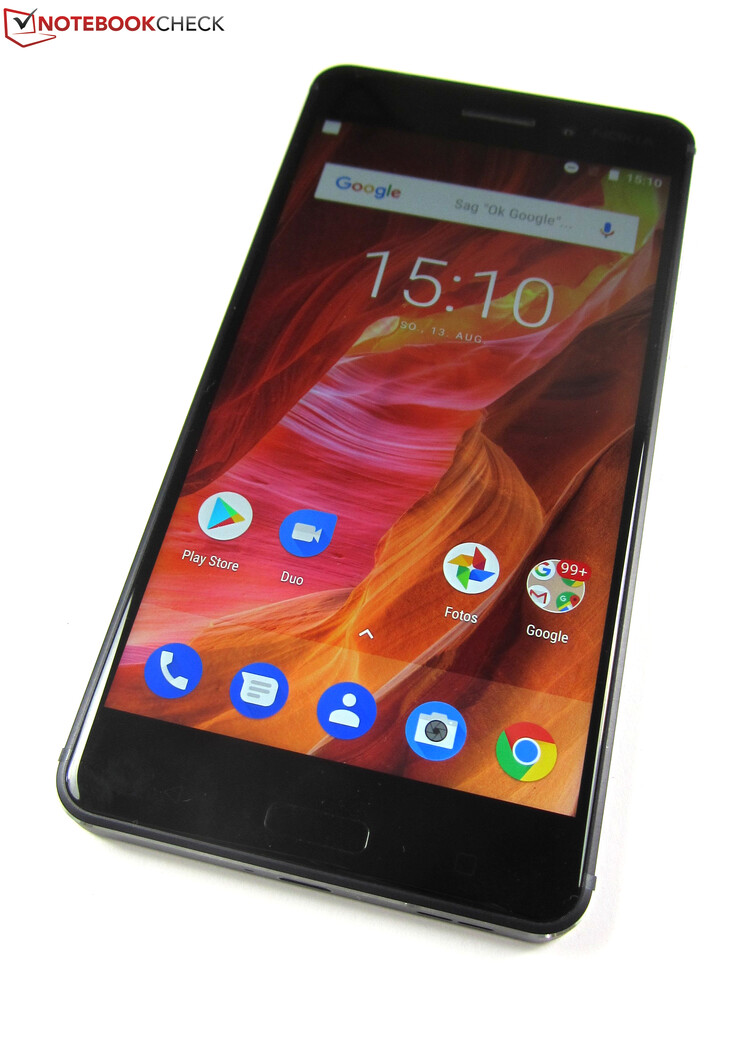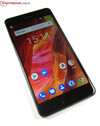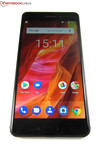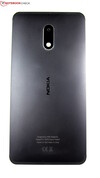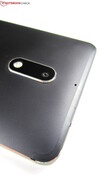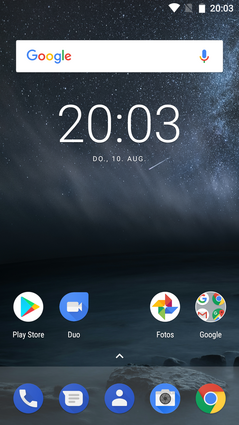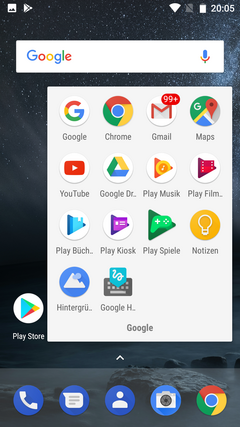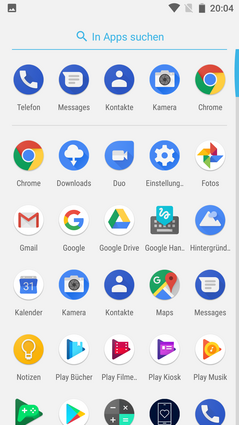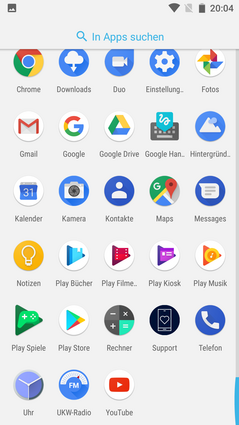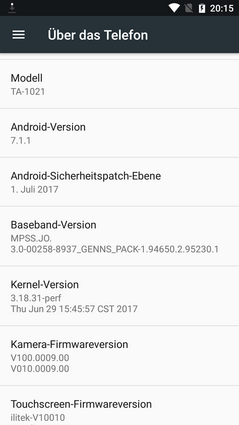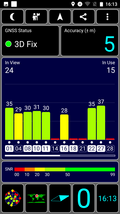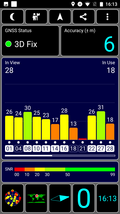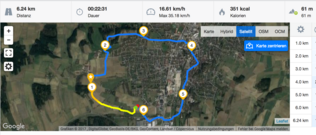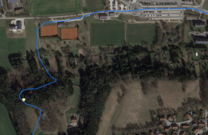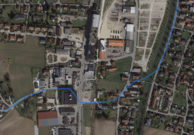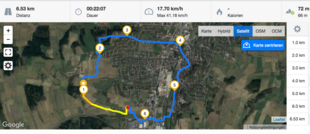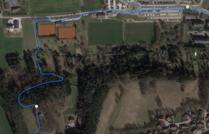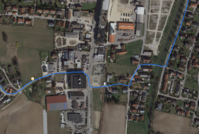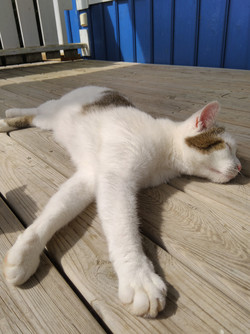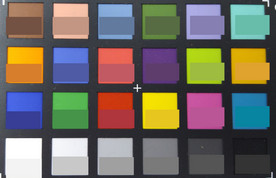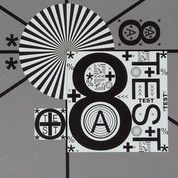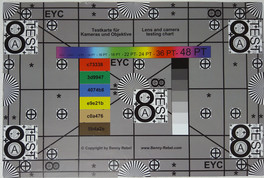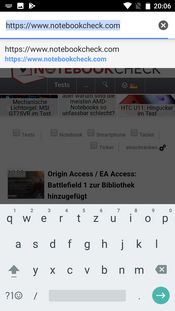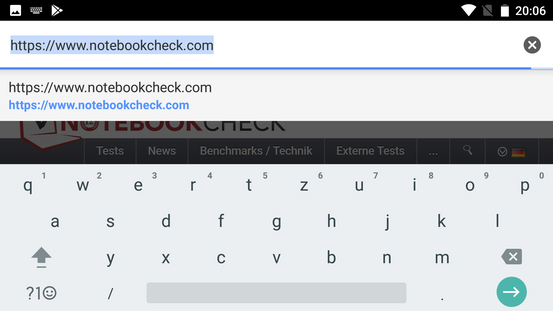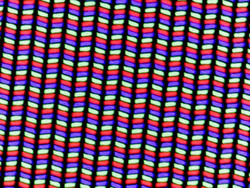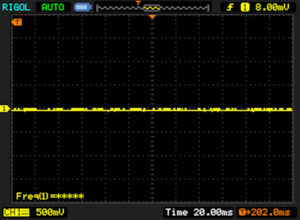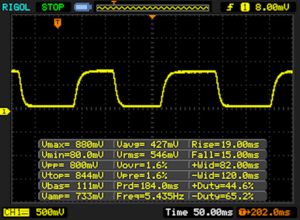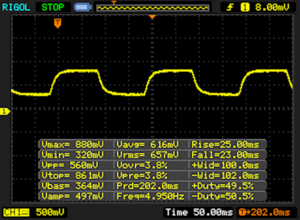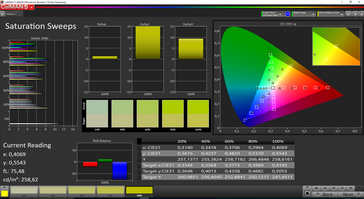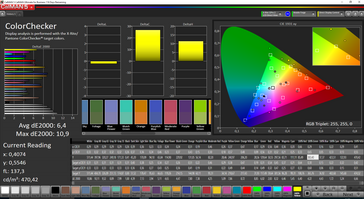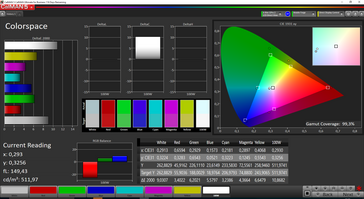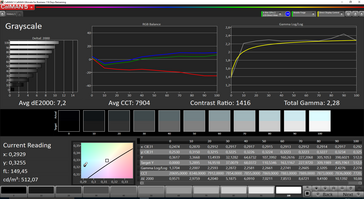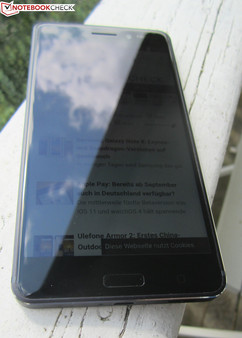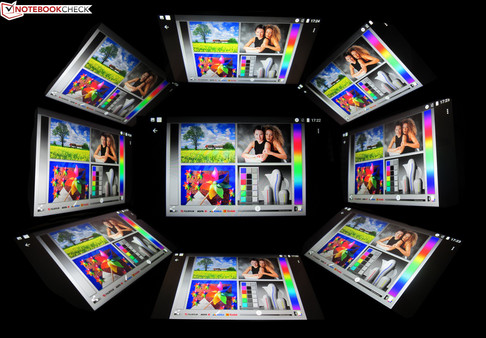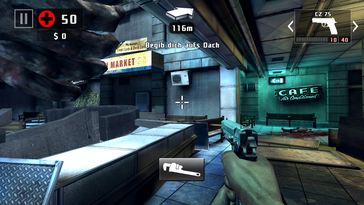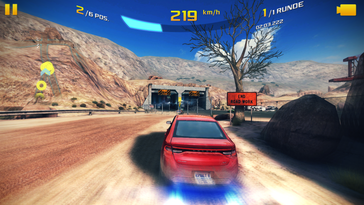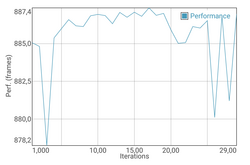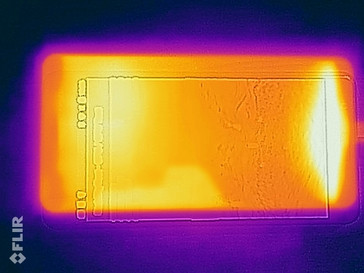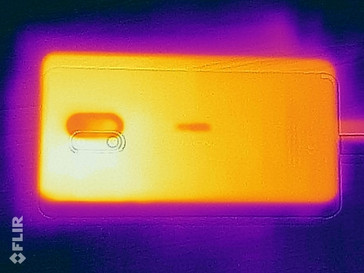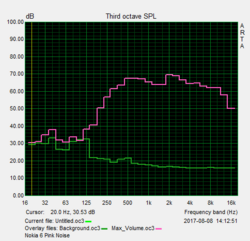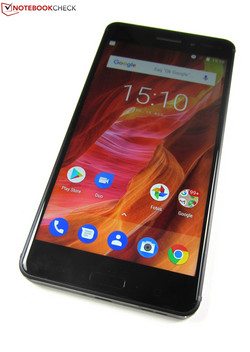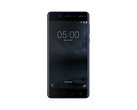Nokia 6 Smartphone Review
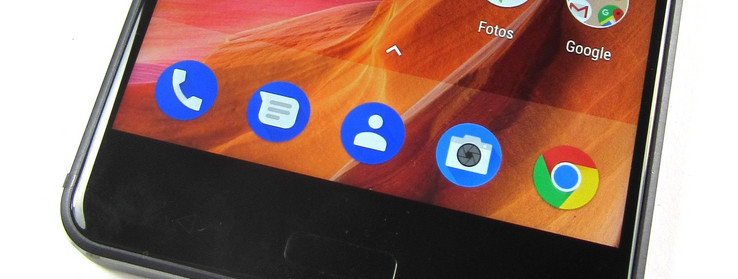
For the original German review, see here.
All good things come in threes: After the Nokia 3 and the Nokia 5, the Finnish manufacturer now introduced the Nokia 6. While the first two smartphones were more positioned in the entry-level market, the Nokia 6 top model seeks to score in the highly competitive mid-range segment. For that, the manufacturer uses the same SoC that already runs in the Nokia 5, the Qualcomm Snapdragon 430 octa-core SoC.
However, in the Nokia 6 the SoC has a little more work to do, since instead of an HD display in the 5.0-inch or 5.2-inch format as used by the other smartphones, our test candidate uses a 5.5-inch Full HD display. To make up for this, Nokia offers a little more RAM – 3 instead of 2 GB as in the Nokia 3 and the Nokia 5 – and combines this with larger internal storage (32 GB) and a higher-resolution main camera (16 MP). The Nokia 6 is also operated by a "pure" Android 7.1.1. To a large extent, it manages without software additions and is almost identical to stock Android. (The Nokia 6 starts from $230 in the US.)
How well can the Nokia 6 stand up against the current mid-range smartphones? To find out, we test it against the Huawei P8 Lite (2017), the Lenovo Moto G5, the LG K10 (2017), the Samsung Galaxy A5 (2017), and the Wiko U Feel Prime. Since the same SoC is used in the Nokia 5, it also joins our comparison.
Case
The Nokia 6 has a metal case, which according to the manufacturer is cut from a single aluminum block in a process taking 55 minutes. As in the Nokia 5, the front and back with their rounded edges and corners are joined together without a gap, creating a very sturdy construction which in our test can neither be bent nor be pushed in. All this gives the user an impression of holding a high-quality smartphone in their hands.
In the Nokia 6, the glass front made of Corning Gorilla Glass is surrounded by an additional shiny connecting seam, which increases the impression of quality. Aside from that and the larger form factor, the Nokia 6 is almost identical outside to the Nokia 5. The Android keys together with the fingerprint sensor placed in the Home button as well as the webcam above the display are underneath the glass cover. The sturdy physical keys (power key and volume rocker) are located on the right side, and the main camera together with its dual-LED flash sticks out from the back cover by a few millimeters.
The resolution of the Nokia's main camera module is 16 MP (compared to the 13 MP of the Nokia 5) and also does not take quite as much space on the back as in the Nokia 5. However, it sticks out from the case a tiny bit more, so that the smartphone tilts to the side easier if you touch the display when it is lying on the table. The Nokia 5 also had this effect, but we were hardly bothered by it there. But since it is wider, our test candidate now offers more target area and wobbles easier. During single finger inputs this is not a problem, but if you need to type in a URL or longer text, this wobble effect can quickly become annoying.
Nokia offers its 5.5-inch smartphone in five colors. You can choose among a matte black as in our test unit, or silver/white, a tempered blue, matte copper, or shiny black as a limited edition.
Features
With 3 GB of RAM and 32 GB of internal storage (almost 22 GB of which is unused), the Nokia 6 brings solid features. In addition, it accepts microSD cards up to 128 GB, which can either be formatted as external or internal storage and in the latter case also allow moving apps and app data to the storage card. However, if you use a microSD card, you also lose the second SIM slot, since it is shared by both.
Unfortunately, the USB port only has the Micro-USB rather than the more foolproof Type-C format and only supports USB-2.0 speeds. On the other hand, the Nokia 6 allows the connection of external storage media and peripheral devices via USB-OTG.
Software
Android 7.1.1 runs on the Nokia 6. The manufacturer left the OS in its original state aside from minimal software additions such as a support app. Forgoing unnecessary extras is supposed to assure the continuous supply with security updates. Indeed, the Nokia 6 was well protected at the time of testing, since at the level of July 1, 2017, the Android security patches were very current.
Communication and GPS
Besides GSM quad-band and UMTS quad-band, the Nokia 6 also supports LTE Cat.4 (band 1, 3, 5, 7, 8, 20, 28, 38, 40), allowing for downloads at up to 150 MBit/s and uploads at up to 50 MBit/s. Even though with this network coverage, the smartphone is not quite a world traveler that can link to the mobile net in any place in the world, its communication talents are easily sufficient for use in European countries.
The Nokia 6 masters NFC and Bluetooth 4.1 and communicates in WLAN via 802.11 a/b/g/n, so it can also use the 5-GHz band. In the test, using the Linksys EA8500 reference router, the smartphone transfers data at up to 117 MBit/s, which is practically just as good as the Nokia 5. However, it is possible to do even better: Among our comparison devices, the Samsung Galaxy A5 (2017), which is almost twice as fast at 214 MBit/s, demonstrates how fast data can be transferred in the 5-GHz WLAN.
| Networking | |
| iperf3 transmit AX12 | |
| Samsung Galaxy A5 2017 | |
| Nokia 6 | |
| Nokia 5 | |
| Lenovo Moto G5 | |
| LG K10 2017 | |
| Huawei P8 lite 2017 | |
| Wiko U Feel Prime | |
| iperf3 receive AX12 | |
| Samsung Galaxy A5 2017 | |
| Nokia 5 | |
| Lenovo Moto G5 | |
| Nokia 6 | |
| Wiko U Feel Prime | |
| Huawei P8 lite 2017 | |
| LG K10 2017 | |
The Nokia 7 locates our current position via GPS, and it succeeds indoors just as quickly as outdoors in the test. At 6 and 5 meters, the accuracy was quite high.
Our practice test confirms that the smartphone does its job assiduously. On our about 6.5-kilometer bicycle route, the Nokia 6 practically leads us just as reliably across roads, bridges, and through the woods as the professional Garmin Edge 500 navigation device. Over the whole route there was a discrepancy of barely 300 meters, which should not be of much consequence during everyday app use.
Telephone and Call Quality
The Phone app on the Nokia 6 is identical to the standard Android app and thus offers all the functions that Android users are used to. In our test calls to landlines and mobile phones, the smartphone makes a good impression. The voices of our conversation partners sound clear and loud, while on the other hand sometimes our own voices sound slightly muffled to our conversation partners. The same effect happens when we activate hands-free operation.
Cameras
Nokia has equipped the 6 with a 16-megapixel camera, which works with an aperture of f/2.0 and besides a phase-comparison autofocus, also brings a dual-LED flash for taking pictures in the dark. With full resolution, the images are 3456x4608 pixels (4:3-format) and in the 16:9 format still 2592x4608 pixels (12 MP).
Although pictures taken with the Nokia 6 have vibrant colors, they neither appear comically exaggerated nor unnatural. This fits well with the sharpness, which works fast and by emphasizing the image structures, makes the overall image appear very lively. However, we miss the final precision in the main camera, since image details in areas with homogeneous colors in particular appear slightly blurry when looking closely.
But overall, the Nokia 6 takes good pictures which should not only satisfy the occasional photographer. This also goes for videos, which the smartphone can record in 1080p and at 30 images per second. The 8-megapixel webcam supports the same recording parameters and offers a solid image quality for selfies and video chats.
In addition to the regular test photos, we also evaluate the color accuracy and sharpness under controlled test conditions. We record images in automatic mode without any post-processing or white balance adjustment.
We check the color accuracy with the X-Rite ColorChecker Passport. Result: too bright and intense. While the Nokia consistently misses the target color, it breathes some life into the pictures with its exaggerated color representation. There is nothing to complain about in the image sharpness which remains very high in the test chart even up to the corners.
Accessories and Warranty
Nokia includes a modular charger (5V, 2A), a Micro-USB cable, a set of earphones, a tool to open the SIM drawer, and brief instructions with its smartphone. On its website, the manufacturer also offers a transparent case and a ruggedized case and a sport headset as accessories. At the time of testing, prices or more information on these products were not available.
There is 24 months warranty on the Nokia 6, which also extends to the battery, since it is non-removable. There is only 6 months warranty on the Micro-USB cable, the modular charger, and the earphones. Please see our Guarantees, Return policies and Warranties FAQ for country-specific information.
Input Devices and Operation
The Nokia reacts to inputs quickly, whether they come from the 10-point touchscreen or the two sturdy physical keys. The IPS display reacts to commands from any place with the same sensitivity, and the power button and the volume rocker provide good feedback with their clearly defined pressure points. The operation with the fingerprint sensor, which sits in the Home button and is very reliable, works similarly without any problems. However, from time to time there are small delays, for example when switching between many apps open at the same time or when loading the Android start screen for the first time. Overall this is not really much of an impediment, and there is nothing in the way of smooth operation.
The Nokia 6 uses the standard GBoard Android keyboard. You can install alternative keyboards anytime through the Play Store.
Display
The 5.5-inch IPS display of the Nokia 6 has a resolution of 1920x1080 pixels, reaching a high pixel density of 401 PPI, which is a clear increase compared to the Nokia 5 with its 282 PPI. But even a pixel density that much lower still makes it hard to detect single pixels without a magnifier. Therefore we are justified to speak about a razor-sharp display in the Nokia 6.
At 501.4 cd/m² with a white background, the Nokia 6 is not quite as bright on average as the Nokia 5, but it more than makes up for this with a very even brightness distribution (94%) and very good results for the black value (0.36 cd/m²) and the contrast ratio (1422:1). With an even and at the same time more realistic distribution of bright and dark image areas (APL50), the brightness of 505 cd/m² is even a tiny bit higher. It is very practical that the Nokia 5, which has a maximum brightness of 512 cd/m², also has a brightness sensor and can therefore automatically adapt the display brightness to the environment.
| |||||||||||||||||||||||||
Brightness Distribution: 94 %
Center on Battery: 512 cd/m²
Contrast: 1422:1 (Black: 0.36 cd/m²)
ΔE ColorChecker Calman: 6.4 | ∀{0.5-29.43 Ø4.78}
ΔE Greyscale Calman: 7.2 | ∀{0.09-98 Ø5}
99.3% sRGB (Calman 2D)
Gamma: 2.28
CCT: 7904 K
| Nokia 6 IPS, 1920x1080, 5.5" | Huawei P8 lite 2017 IPS, 1920x1080, 5.2" | Lenovo Moto G5 IPS, 1920x1080, 5" | LG K10 2017 IPS, 1280x720, 5.3" | Nokia 5 IPS, 1280x720, 5.2" | Samsung Galaxy A5 2017 Super AMOLED, 1920x1080, 5.2" | Wiko U Feel Prime IPS, 1920x1080, 5" | |
|---|---|---|---|---|---|---|---|
| Screen | 5% | 27% | -12% | 2% | 40% | 6% | |
| Brightness middle (cd/m²) | 512 | 575 12% | 660 29% | 384 -25% | 630 23% | 539 5% | 411 -20% |
| Brightness (cd/m²) | 501 | 559 12% | 625 25% | 350 -30% | 635 27% | 542 8% | 386 -23% |
| Brightness Distribution (%) | 94 | 91 -3% | 92 -2% | 85 -10% | 90 -4% | 93 -1% | 86 -9% |
| Black Level * (cd/m²) | 0.36 | 0.39 -8% | 0.29 19% | 0.36 -0% | 0.57 -58% | 0.36 -0% | |
| Contrast (:1) | 1422 | 1474 4% | 2276 60% | 1067 -25% | 1105 -22% | 1142 -20% | |
| Colorchecker dE 2000 * | 6.4 | 5.2 19% | 4.9 23% | 6 6% | 5 22% | 1.6 75% | 4.3 33% |
| Colorchecker dE 2000 max. * | 10.9 | 10.3 6% | 7.6 30% | 14 -28% | 8.7 20% | 2.6 76% | 7.9 28% |
| Greyscale dE 2000 * | 7.2 | 7.2 -0% | 4.8 33% | 5.9 18% | 6.9 4% | 1.5 79% | 2.8 61% |
| Gamma | 2.28 96% | 2.4 92% | 2.18 101% | 2 110% | 2.37 93% | 2.28 96% | 2.53 87% |
| CCT | 7904 82% | 7224 90% | 7357 88% | 8042 81% | 8736 74% | 6422 101% | 6589 99% |
* ... smaller is better
Screen Flickering / PWM (Pulse-Width Modulation)
| Screen flickering / PWM not detected | |||
In comparison: 53 % of all tested devices do not use PWM to dim the display. If PWM was detected, an average of 8108 (minimum: 5 - maximum: 343500) Hz was measured. | |||
Display Response Times
| ↔ Response Time Black to White | ||
|---|---|---|
| 34 ms ... rise ↗ and fall ↘ combined | ↗ 19 ms rise | |
| ↘ 15 ms fall | ||
| The screen shows slow response rates in our tests and will be unsatisfactory for gamers. In comparison, all tested devices range from 0.1 (minimum) to 240 (maximum) ms. » 90 % of all devices are better. This means that the measured response time is worse than the average of all tested devices (20.2 ms). | ||
| ↔ Response Time 50% Grey to 80% Grey | ||
| 48 ms ... rise ↗ and fall ↘ combined | ↗ 25 ms rise | |
| ↘ 23 ms fall | ||
| The screen shows slow response rates in our tests and will be unsatisfactory for gamers. In comparison, all tested devices range from 0.165 (minimum) to 636 (maximum) ms. » 82 % of all devices are better. This means that the measured response time is worse than the average of all tested devices (31.6 ms). | ||
Like the Nokia 5 before, the Nokia 6 is also unable to produce a balanced color display. Looking at it with the naked eye, there is actually nothing to complain about in the display, even if it always appears slightly cool. If you look closer at the IPS display with the spectral photometer and the CalMAN analysis software, this impression is confirmed by the measurements. At 7904 K, the color temperature is clearly above the ideal value, causing the blue tint of the display. With DeltaE values of 6.4 and 7.2, the color and grayscale displays are also not in the optimal range (DeltaE < 3).
Due to its high brightness, the Nokia 6 can also be used outdoors without any problems, as long as you avoid direct sunlight on the display. The optional "Sunlight Mode," which is supposed to improve readability in exactly such a case, was very unremarkable in our test. We did not really notice any difference between the activated or deactivated Sunlight function. However, the high viewing-angle stability of the IPS displays clearly stands out. It always assures a good view of the content, whether you are using the smartphone outdoors or indoors.
Performance
With the Qualcomm Snapdragon 430, the Nokia 6 uses an SoC of the lower mid-range, with 8 cores that have a clock speed of 1.4 GHz. The Qualcomm Adreno 505 takes care of the graphics calculations. Even though the smartphone has 3 GB of RAM, sometimes it takes its time to switch between menus or open applications during the test. After powering it up, almost every time we also encountered the short notice that the Android start screen is loading. However, overall the SoC delivers sufficient power to assure smooth Android operation, although in the synthetic benchmarks, the Huawei P8 Lite (2017) and the Samsung Galaxy A5 (2017) are still a little faster.
| AnTuTu v6 - Total Score (sort by value) | |
| Nokia 6 | |
| Huawei P8 lite 2017 | |
| Lenovo Moto G5 | |
| LG K10 2017 | |
| Nokia 5 | |
| Samsung Galaxy A5 2017 | |
| Wiko U Feel Prime | |
| PCMark for Android | |
| Work performance score (sort by value) | |
| Nokia 6 | |
| Huawei P8 lite 2017 | |
| Lenovo Moto G5 | |
| Nokia 5 | |
| Samsung Galaxy A5 2017 | |
| Wiko U Feel Prime | |
| Work 2.0 performance score (sort by value) | |
| Nokia 6 | |
| Lenovo Moto G5 | |
| LG K10 2017 | |
| Nokia 5 | |
| Samsung Galaxy A5 2017 | |
| Geekbench 4.4 | |
| 64 Bit Single-Core Score (sort by value) | |
| Nokia 6 | |
| Lenovo Moto G5 | |
| LG K10 2017 | |
| Nokia 5 | |
| Samsung Galaxy A5 2017 | |
| 64 Bit Multi-Core Score (sort by value) | |
| Nokia 6 | |
| Lenovo Moto G5 | |
| LG K10 2017 | |
| Nokia 5 | |
| Samsung Galaxy A5 2017 | |
| Compute RenderScript Score (sort by value) | |
| Lenovo Moto G5 | |
| LG K10 2017 | |
| Samsung Galaxy A5 2017 | |
| GFXBench (DX / GLBenchmark) 2.7 | |
| T-Rex Onscreen (sort by value) | |
| Nokia 6 | |
| Huawei P8 lite 2017 | |
| Lenovo Moto G5 | |
| LG K10 2017 | |
| Nokia 5 | |
| Samsung Galaxy A5 2017 | |
| Wiko U Feel Prime | |
| 1920x1080 T-Rex Offscreen (sort by value) | |
| Nokia 6 | |
| Huawei P8 lite 2017 | |
| Lenovo Moto G5 | |
| LG K10 2017 | |
| Nokia 5 | |
| Samsung Galaxy A5 2017 | |
| Wiko U Feel Prime | |
| GFXBench 3.0 | |
| on screen Manhattan Onscreen OGL (sort by value) | |
| Nokia 6 | |
| Huawei P8 lite 2017 | |
| Lenovo Moto G5 | |
| LG K10 2017 | |
| Nokia 5 | |
| Samsung Galaxy A5 2017 | |
| Wiko U Feel Prime | |
| 1920x1080 1080p Manhattan Offscreen (sort by value) | |
| Nokia 6 | |
| Huawei P8 lite 2017 | |
| Lenovo Moto G5 | |
| LG K10 2017 | |
| Nokia 5 | |
| Samsung Galaxy A5 2017 | |
| Wiko U Feel Prime | |
| GFXBench 3.1 | |
| on screen Manhattan ES 3.1 Onscreen (sort by value) | |
| Nokia 6 | |
| Huawei P8 lite 2017 | |
| Lenovo Moto G5 | |
| LG K10 2017 | |
| Nokia 5 | |
| Samsung Galaxy A5 2017 | |
| Wiko U Feel Prime | |
| 1920x1080 Manhattan ES 3.1 Offscreen (sort by value) | |
| Nokia 6 | |
| Huawei P8 lite 2017 | |
| Lenovo Moto G5 | |
| LG K10 2017 | |
| Nokia 5 | |
| Samsung Galaxy A5 2017 | |
| Wiko U Feel Prime | |
| GFXBench | |
| on screen Car Chase Onscreen (sort by value) | |
| Nokia 6 | |
| Huawei P8 lite 2017 | |
| Lenovo Moto G5 | |
| LG K10 2017 | |
| Nokia 5 | |
| Samsung Galaxy A5 2017 | |
| Wiko U Feel Prime | |
| 1920x1080 Car Chase Offscreen (sort by value) | |
| Nokia 6 | |
| Huawei P8 lite 2017 | |
| Lenovo Moto G5 | |
| LG K10 2017 | |
| Nokia 5 | |
| Samsung Galaxy A5 2017 | |
| Wiko U Feel Prime | |
Surfing on the web does not present any larger challenges for the Nokia 6, since on the surface everything runs without any trouble. Web content is loaded quickly and we hardly, if at all, noticed any delays when loading sites or tapping any navigation elements. The Nokia 6 hits its limits only in demanding HTML5 pages. Such a case is, for example, the Let’s Play Ouigo pinball game (letsplay.ouigo.com), which only runs as a slideshow on the screen.
| JetStream 1.1 - Total Score | |
| Samsung Galaxy A5 2017 (Samsung Browser (Chrome 44)) | |
| Huawei P8 lite 2017 (Chrome 55) | |
| Nokia 5 (Chrome 56.0.2924.87) | |
| Wiko U Feel Prime (Chrome 55) | |
| LG K10 2017 (Chrome 57) | |
| Lenovo Moto G5 (Chrome 57) | |
| Nokia 6 (Chrome 59.0.3071.125) | |
| Octane V2 - Total Score | |
| Samsung Galaxy A5 2017 (Samsung Browser (Chrome 44)) | |
| Huawei P8 lite 2017 (Chrome 55) | |
| LG K10 2017 (Chrome 57) | |
| Wiko U Feel Prime (Chrome 55) | |
| Nokia 5 (Chrome 56.0.2924.87) | |
| Nokia 6 (Chrome 59.0.3071.125) | |
| Lenovo Moto G5 (Chrome 57) | |
| Mozilla Kraken 1.1 - Total | |
| Nokia 6 (Chrome 59.0.3071.125) | |
| LG K10 2017 (Chrome 57) | |
| Lenovo Moto G5 (Chrome 57) | |
| Wiko U Feel Prime (Chrome 55) | |
| Nokia 5 (Chrome 56.0.2924.87) | |
| Huawei P8 lite 2017 (Chrome 55) | |
| Samsung Galaxy A5 2017 (Samsung Browser (Chrome 44)) | |
| WebXPRT 2015 - Overall | |
| Samsung Galaxy A5 2017 (Samsung Browser (Chrome 44)) | |
| Huawei P8 lite 2017 (Chrome 55) | |
| Nokia 6 (Chrome 59.0.3071.125) | |
| Lenovo Moto G5 (Chrome 57) | |
| Nokia 5 (Chrome 56.0.2924.87) | |
| LG K10 2017 (Chrome 57) | |
* ... smaller is better
During reading and writing, the Nokia 6 does well. Access to the internal storage is just as fast as in the competition and fulfills its duty, which is the fast loading of apps and app data. The read and write performance of the microSD card also fits into this picture. Even though the smartphone does not reach the bandwidth of our Toshiba Exceria Pro M501 reference card by far (UHS-II, Class 3, writing up to 270 MB/s, reading up to 150 MB/s), it is the fastest device in our comparison with up to 84.6 MB/s.
| Nokia 6 | Huawei P8 lite 2017 | Lenovo Moto G5 | LG K10 2017 | Nokia 5 | Samsung Galaxy A5 2017 | Wiko U Feel Prime | |
|---|---|---|---|---|---|---|---|
| AndroBench 3-5 | -30% | 31% | -14% | -1% | -12% | 6% | |
| Sequential Read 256KB (MB/s) | 273.1 | 165.8 -39% | 230.6 -16% | 246.1 -10% | 255.6 -6% | 182 -33% | 270.9 -1% |
| Sequential Write 256KB (MB/s) | 77.1 | 42 -46% | 45.6 -41% | 43.6 -43% | 74.9 -3% | 77.1 0% | 137.3 78% |
| Random Read 4KB (MB/s) | 33.8 | 38.7 14% | 37.6 11% | 25.1 -26% | 40.54 20% | 22.41 -34% | 55 63% |
| Random Write 4KB (MB/s) | 11.34 | 8 -29% | 37.9 234% | 10.8 -5% | 8.39 -26% | 12.13 7% | 9.4 -17% |
| Sequential Read 256KB SDCard (MB/s) | 84.6 | 53.1 ? -37% | 78.5 ? -7% | 77.4 ? -9% | 83.9 -1% | 73.7 ? -13% | 41.98 ? -50% |
| Sequential Write 256KB SDCard (MB/s) | 56.6 | 32.1 ? -43% | 58 ? 2% | 61.6 ? 9% | 62 10% | 56 ? -1% | 35.21 ? -38% |
Games
To a large extent, the Nokia 6 displays current games smoothly and pleases with its precise position and movement sensor. However, during some games there are still some stutters. For example, in our test they happen in Asphalt 8: Airborne as soon as you select the maximum settings in the graphics details. Although the game, which is very demanding for the hardware, still runs halfway smooth at 24 FPS, in terms of gameplay it does not feel very satisfying anymore. There are no problems during our second test game, Dead Trigger 2, which is also quite demanding on the smartphone. The zombie shooter also plays butter-smooth at 50 FPS on maximum details.
With that, the Nokia 6 is slightly less suitable for games than the Nokia 5, even if almost all the games should run without any trouble. The 5.2-inch sibling model does better, because it uses a lower resolution of 1280x720 pixels. The same SoC has to work harder in the Nokia 6, since here it needs to display content in Full HD resolution.
| Asphalt 8: Airborne | |||
| Settings | Value | ||
| high | 24 fps | ||
| very low | 30 fps | ||
| Dead Trigger 2 | |||
| Settings | Value | ||
| high | 50 fps | ||
Emissions
Temperature
During our tests, the Nokia 6 warms up to 39.8 °C (104 °F) under load. If you include the values of the front and back, on average our test candidate levels out at a non-critical 36.6 °C (98 °F). This does not make it uncomfortable to hold the smartphone in the hands even for longer gaming sessions.
We test with the GFXBench battery test whether there might be some thermal abnormalities and in the worst case, if the SoC has to be throttled. But after 30 runs with the Manhattan-3.1 scenario of GFXBench we can reassure you: The frame rate remains consistently high during the whole stress test, so throttling does not occur.
(+) The maximum temperature on the upper side is 39.8 °C / 104 F, compared to the average of 35.2 °C / 95 F, ranging from 21.9 to 247 °C for the class Smartphone.
(+) The bottom heats up to a maximum of 38.4 °C / 101 F, compared to the average of 34 °C / 93 F
(±) In idle usage, the average temperature for the upper side is 32.8 °C / 91 F, compared to the device average of 32.9 °C / 91 F.
Speaker
The mono speaker of the Nokia 6 is located at the bottom, to the right of the Micro-USB 2.0 port, at exactly the same spot as in the Nokia 5. The sound quality of the two smartphones is also very similar. Even though the speaker in the Nokia 5 has a slightly lower maximum volume - 78 compared to 83.6 dB(A) - it reproduces mids and highs just as linear. We can hardly detect any bass, if at all, even upon a closer listen. This is neither out-of-the-ordinary nor problematic for a typical smartphone speaker. All in all, the Nokia 6 delivers a decent-quality sound. If you use the included earphones, the sound sounds again much better.
Nokia 6 audio analysis
(±) | speaker loudness is average but good (78 dB)
Bass 100 - 315 Hz
(-) | nearly no bass - on average 17% lower than median
(±) | linearity of bass is average (11.4% delta to prev. frequency)
Mids 400 - 2000 Hz
(+) | balanced mids - only 2.5% away from median
(+) | mids are linear (4.1% delta to prev. frequency)
Highs 2 - 16 kHz
(+) | balanced highs - only 2% away from median
(+) | highs are linear (2.6% delta to prev. frequency)
Overall 100 - 16.000 Hz
(±) | linearity of overall sound is average (16.4% difference to median)
Compared to same class
» 6% of all tested devices in this class were better, 5% similar, 88% worse
» The best had a delta of 11%, average was 35%, worst was 134%
Compared to all devices tested
» 26% of all tested devices were better, 6% similar, 68% worse
» The best had a delta of 4%, average was 24%, worst was 134%
Nokia 5 audio analysis
(+) | speakers can play relatively loud (83.6 dB)
Bass 100 - 315 Hz
(-) | nearly no bass - on average 19.5% lower than median
(±) | linearity of bass is average (10.4% delta to prev. frequency)
Mids 400 - 2000 Hz
(+) | balanced mids - only 4.3% away from median
(+) | mids are linear (3.6% delta to prev. frequency)
Highs 2 - 16 kHz
(+) | balanced highs - only 4.7% away from median
(+) | highs are linear (3.7% delta to prev. frequency)
Overall 100 - 16.000 Hz
(±) | linearity of overall sound is average (19.4% difference to median)
Compared to same class
» 27% of all tested devices in this class were better, 8% similar, 65% worse
» The best had a delta of 11%, average was 35%, worst was 134%
Compared to all devices tested
» 47% of all tested devices were better, 7% similar, 46% worse
» The best had a delta of 4%, average was 24%, worst was 134%
Huawei P8 lite 2017 audio analysis
(+) | speakers can play relatively loud (83.6 dB)
Bass 100 - 315 Hz
(-) | nearly no bass - on average 32.1% lower than median
(±) | linearity of bass is average (11.2% delta to prev. frequency)
Mids 400 - 2000 Hz
(+) | balanced mids - only 4% away from median
(+) | mids are linear (6.4% delta to prev. frequency)
Highs 2 - 16 kHz
(±) | higher highs - on average 7.9% higher than median
(+) | highs are linear (4.8% delta to prev. frequency)
Overall 100 - 16.000 Hz
(±) | linearity of overall sound is average (27.6% difference to median)
Compared to same class
» 72% of all tested devices in this class were better, 5% similar, 24% worse
» The best had a delta of 11%, average was 35%, worst was 134%
Compared to all devices tested
» 84% of all tested devices were better, 3% similar, 13% worse
» The best had a delta of 4%, average was 24%, worst was 134%
Frequency comparison (checkboxes selectable!)
Battery Life
Power Consumption
The Nokia 6 is not too economic with its power reserves. In the comparison, only the Huawei P8 Lite (2017) demands more power from the battery with a maximum of up to 6.3 watts. The Nokia 6 is not much better (5.85 watts) and thus remains behind the other five comparison devices. Those include the Nokia 5, which uses about 7% less power overall. The Samsung Galaxy A5 (2017) is the most efficient, using 22% less than the Nokia 6.
| Off / Standby | |
| Idle | |
| Load |
|
Key:
min: | |
| Nokia 6 3000 mAh | Huawei P8 lite 2017 3000 mAh | Lenovo Moto G5 2800 mAh | LG K10 2017 2800 mAh | Nokia 5 3000 mAh | Samsung Galaxy A5 2017 3000 mAh | Wiko U Feel Prime 3000 mAh | |
|---|---|---|---|---|---|---|---|
| Power Consumption | -49% | -0% | 8% | 7% | 22% | 8% | |
| Idle Minimum * (Watt) | 0.63 | 1.44 -129% | 0.73 -16% | 0.76 -21% | 0.52 17% | 0.64 -2% | 0.66 -5% |
| Idle Average * (Watt) | 1.75 | 2.47 -41% | 1.64 6% | 1.59 9% | 1.78 -2% | 1.36 22% | 1.66 5% |
| Idle Maximum * (Watt) | 1.87 | 2.58 -38% | 1.68 10% | 1.61 14% | 1.96 -5% | 1.4 25% | 1.76 6% |
| Load Average * (Watt) | 3.56 | 4.55 -28% | 3.46 3% | 3.24 9% | 3.23 9% | 2.53 29% | 2.85 20% |
| Load Maximum * (Watt) | 5.85 | 6.3 -8% | 6.13 -5% | 4.15 29% | 4.88 17% | 3.63 38% | 5.01 14% |
* ... smaller is better
Battery Life
Despite a similar battery capacity (300 mAh), the Nokia 6 is not able to achieve the good runtimes of the Nokia 5. A great part of this should be the larger screen (5.5 instead of 5.2-inch), which displays content in Full HD instead of the lower HD resolution of 1280x720 pixels.
In the comparison, the Nokia 6 still does fairly well, since with a runtime of more than 11 hours in the WLAN surf test, it has enough power reserves to last through a whole day away from the outlet. It is about as untiring overall as the Huawei P8 Lite (2017) and the LG K10 (2017), which last only a tiny bit longer. As was already hinted in the power consumption, no other smartphone can reach even close to the Samsung Galaxy A5 (2017) in terms of the battery life.
| Nokia 6 3000 mAh | Huawei P8 lite 2017 3000 mAh | Lenovo Moto G5 2800 mAh | LG K10 2017 2800 mAh | Nokia 5 3000 mAh | Samsung Galaxy A5 2017 3000 mAh | Wiko U Feel Prime 3000 mAh | |
|---|---|---|---|---|---|---|---|
| Battery runtime | 3% | -9% | 3% | 25% | 64% | -20% | |
| Reader / Idle (h) | 28.3 | 22.1 -22% | 20.7 -27% | 24.6 -13% | 29.5 4% | 40.3 42% | 20.9 -26% |
| H.264 (h) | 9 | 10.7 19% | 10.3 14% | 10.2 13% | 13.2 47% | 16.4 82% | |
| WiFi v1.3 (h) | 11.2 | 10.1 -10% | 9.4 -16% | 8.9 -21% | 11.9 6% | 14.1 26% | 9.6 -14% |
| Load (h) | 3.8 | 4.7 24% | 3.5 -8% | 5 32% | 5.4 42% | 7.8 105% |
Pros
Cons
Verdict
The most expensive model of Nokia's new smartphone trio distinguishes itself from the Nokia 3 and the Nokia 5 with its larger form factor and 5.5-inch Full HD display. The working memory and internal storage also received an upgrade, being more generous at 3 GB and 32 GB respectively. The advantages of the Nokia 6 also include many features that we already liked in the Nokia 5: many LTE bands, a dual-SIM slot, a fingerprint sensor, Android 7.1 almost in its original state, a long battery life, and great workmanship. With its 16-MP camera, the Nokia 6 takes slightly better pictures than the Nokia 5, but in the end the difference is rather small.
The Nokia 6 is a good smartphone but does not offer much additional value compared to the more affordable Nokia 5. There really is only one argument for its purchase: the larger and higher-resolution display.
"Marginally" is also the keyword in our list of complaints. If you disregard the display, the Nokia 6 cannot significantly differentiate itself from the more affordable Nokia 5. Since with the Qualcomm Snapdragon 430 the same SoC is inside, both smartphones have more or less the same speed. Although this is enough to swim with the mid-range, a faster processor would have done the Nokia 6 some good. In particular during gaming we would have liked that, since here the Snapdragon 430 has visibly more trouble to fill the Full HD display with content than in the Nokia 5. We also missed a USB Type-C connection. The example of the Samsung Galaxy A5 (2017) shows that this is also possible in this price range.
Nokia 6
- 08/17/2017 v6 (old)
Manuel Masiero




